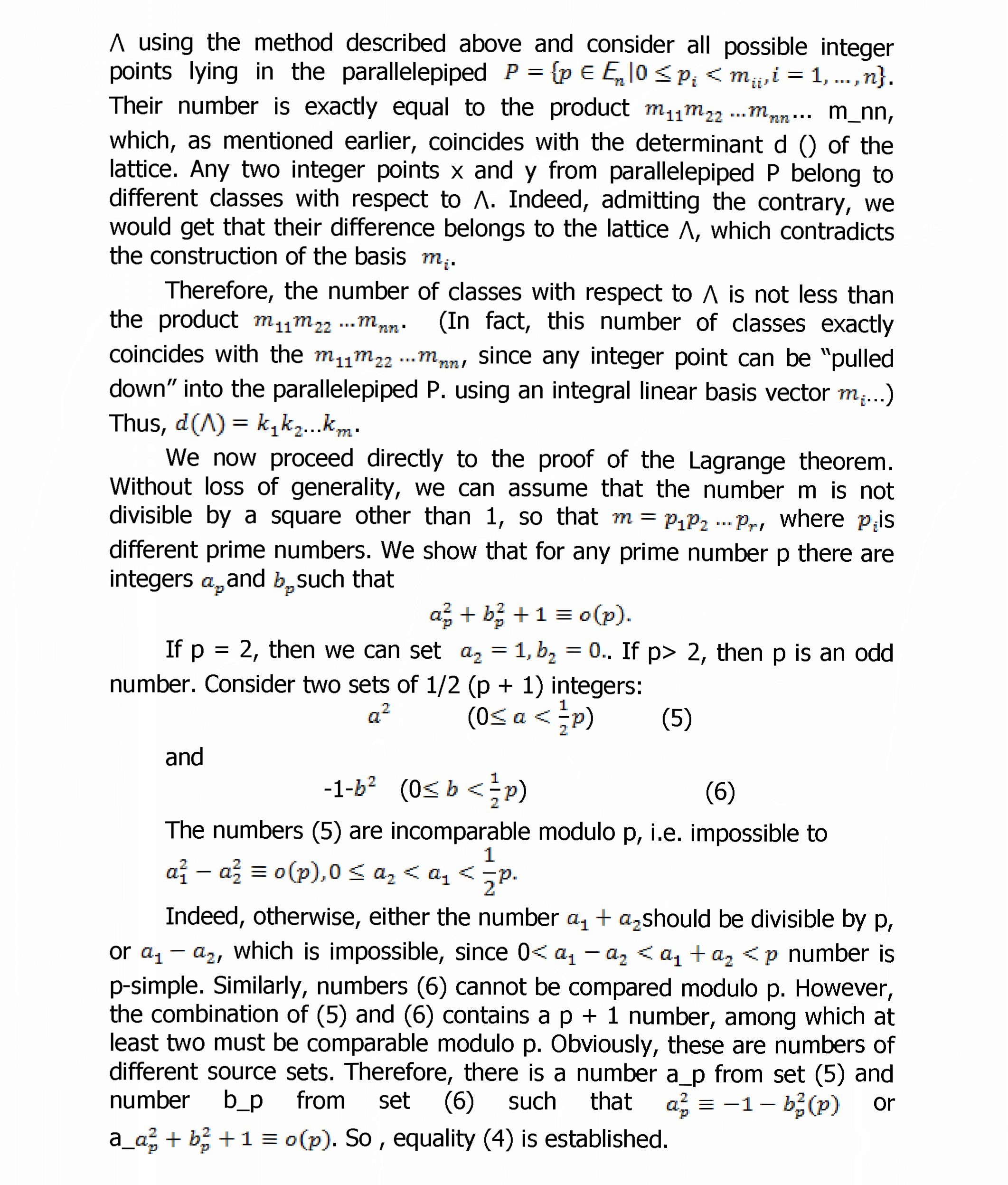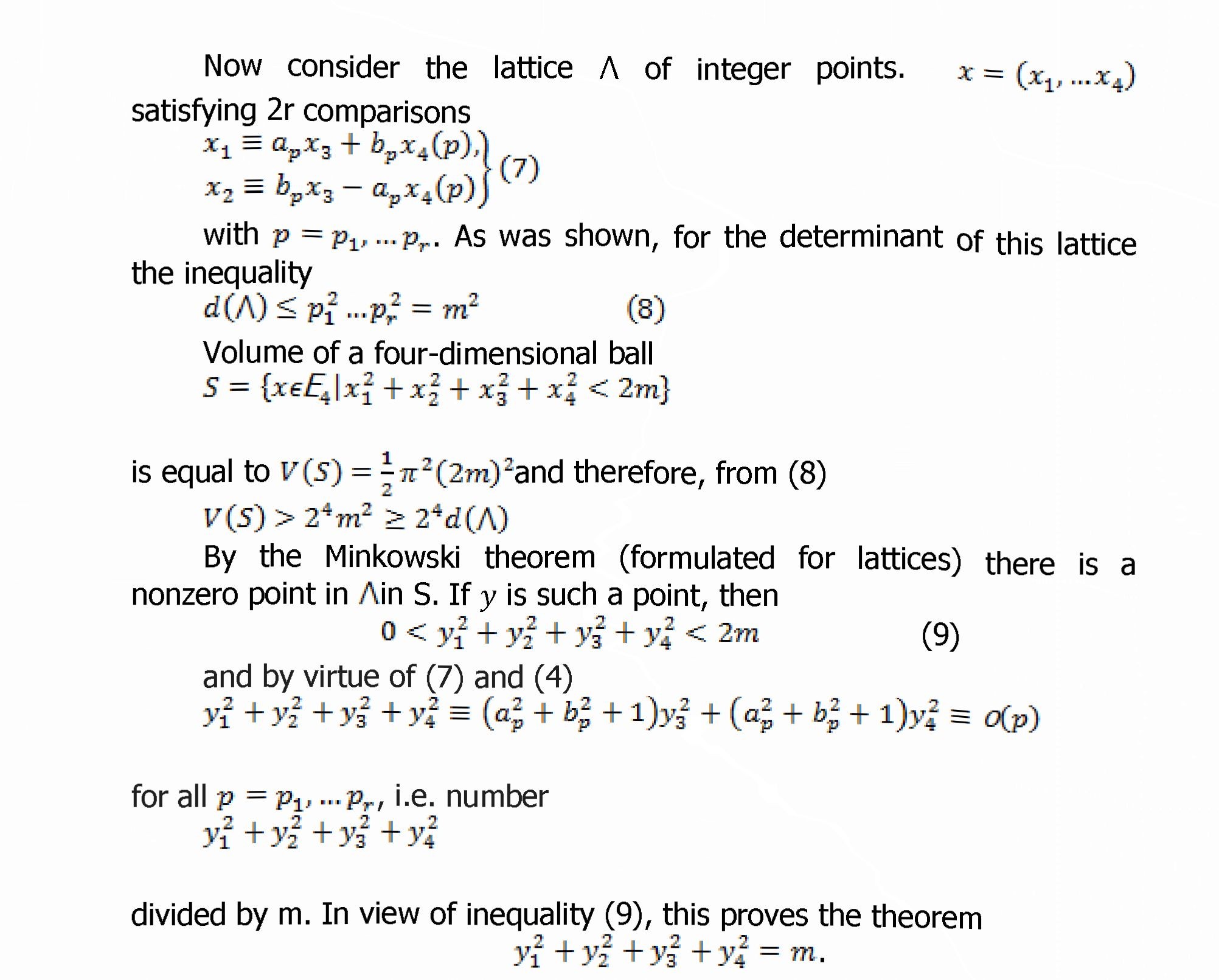Abstract
The article examined as the theoretician-Lagrange's four-squares theorem follows from the geometric Minkowski theorem on a convex body. The proof will use some properties of integer lattices. We will represent consecutive natural numbers in the form of a sum of squares of integers, trying to ensure that in these representations there are as few terms as possible. It can be verified that of the first fifteen natural numbers, only the numbers 7 and 15 are represented as the sum of four squares of integers, the rest can be represented as the sum of less than four squares of integers.
We will represent consecutive natural numbers in the form of a sum of squares of integers, trying to ensure that in these representations there are as few terms as possible. We will get the next set of views-
1=1
2=1+1
3=1+1+1
4=22
5= 22 + 1
6=22+l+l
7=22+l+l+l
Then we can make sure that of the first fifteen natural numbers, only the numbers 7 and 15 are represented as the sum of four squares of integers, the rest can be represented as the sum of less than four squares of integers. In 1770, J.L.Lagrange proved (and this is the four-square Lagrange theorem) that any natural number can be represented as the sum of four squares of integers. In other words, for any natural m, the equation
X1+ %2 + X3 +X4= ГП
has at least one integer solution.
The four-square Lagrange problem is a special case of the so-called Waring problem (1770), which consists in proving the statement: any integer m>l can be represented as a sum
m = a" + a% + -+a”
a certain number к of the terms, each of which is the -th power of a nonnegative integer, and the number of the terms of к depend only on n: к = к (n). Thus, the Lagrange theorem states that к (2) = 4.
The first general solution to the Waring problem (for arbitrary natural n) was found by D. Hilbert in 1909, but he received a rather rough estimate for the number of terms. Outstanding Soviet mathematician I.M. Vinogradov gave a new solution (1934) to the problem of Waring, which is close to the final one.
We now want to demonstrate how the theoretician Lagrange's foursquare number theorem follows from the geometric Minkowski theorem on a convex body. The proof will use some properties of integer lattices.
We note first that every set of integer-valued vectors At= En is a lattice if 1) there are n linearly independent vectors in and 2) the sum and difference of any vectors from also belongs to A. To prove this fact, we construct a basis A in the following special way (the properties of this basis will be further used). Take the vector Tn1 GA such that for its first component was performed
Tn11 = TninIx1I Vx = (X1, ....,xn) G A, X1ZjfcO
If such a vector Tn1 were not found, this would mean that the whole set A lies in the hyperplane X1 = Oand, therefore, cannot, contrary to (1), contain n linearly independent vectors.
Since, by condition (-Tn1) G A , we can assume that Tn1 > 0.
If x = (xp ....,xn) is an arbitrary vector in, then X1 = ^1Tn1 for some integer Indeed, otherwise we would get X1 = pmu + q, where p and q are integers, and Iql < Tn11.
127



References:
- Belousov E.G. Introduction to convex analysis and integer programming. -M.: Moscow State University Publishing House, 1977.
- Cassels J.V.S. Introduction to the geometry of numbers. -M.: Mir, 1965.
- Manin Yu.I. Computable and uncomputable. - M .: Soviet Radio, 1980.
- Mathematical optimization: problems Ofsolvability and stability. - M .MGU Publishing House, 1986.
- Tarasov, S.P., Khachiyan, L.G. The boundaries Ofsolutions and the algorithmic complexity of the systems of convex Diophantine inequalities Ц DAN SSSR, 198O.-T.255.-№2.
- Hu T. Integer programming and flows in networks. - M .: Mir, 1974.
- Bank B., Guddat J., Klatte D., et al. Non-Linear Parametric Optimization. Berlin, Akademie Verlag, 1982.